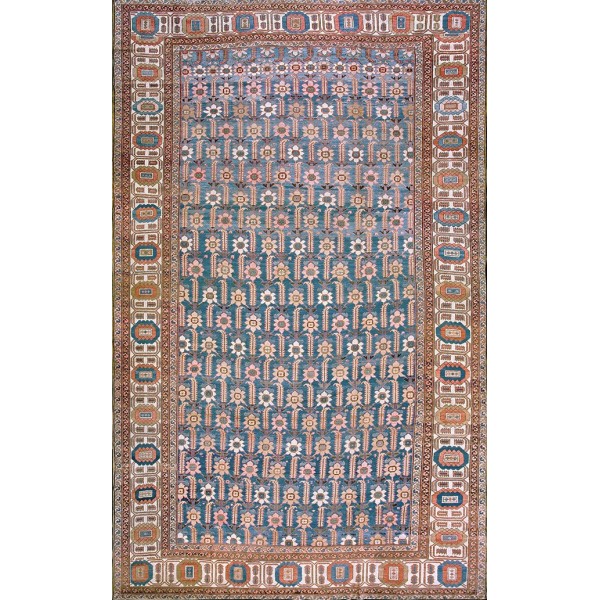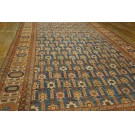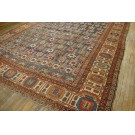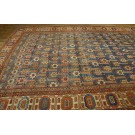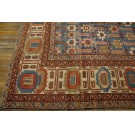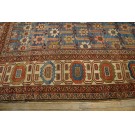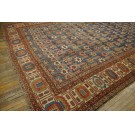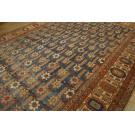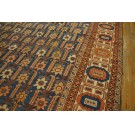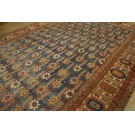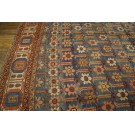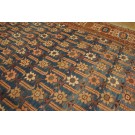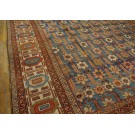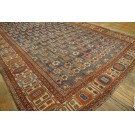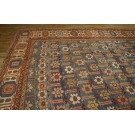19th Century N.W. Persian Bakshaiesh Carpet
Type: Heriz Carpet (Bakhshaiesh Type)
Origin: Azerbaijan Province, NW Persia
Structure
Warp: cotton, off white, natural, handspun, Z-4-S
Weft: cotton, off white, natural, handspun, Z-2, 3, 4-S; mostly one shoot straight, some two shoots alternating.
Pile: wool, Z-2; alternate warps depressed 0-45 ° in irregular areas; spots of knot bulge on verso; horizontal 6/inch x vertical 7-8/inch = 42-48/square inch
Sides: 2 cords & 2 body warps, inner cord weft-attached; wrapped figure – 8 wide in tan Z-2 wool.
Ends: no original finish
Pattern
A field abrashed in various shades of a luminous and attractive light blue displays an ascending overall pattern of linked rosettes separated by stiff leaves with curling lower tips. The leaves switch orientation in alternate rows. This rare design is almost surely derived from a Persian silk brocade textile in which was more fluid, but less angular and vigorous than in our carpet. The pattern was not rigorously followed, however, as there is a row of smaller rosettes near the bottom of the field. This anomaly was not repeated and does not serve to better fit the pattern repeat into the allotted area. The pattern seems to be unique and no other examples are recorded, implying that this carpet was a custom order.
The main ivory border of stiffly linked octagons (highly stylized rosettes?) with attendant hyper-formalized floating leaves is a variant of the “crab” border of the Caucasus and NW Persia. The pattern appears on other pieces from this area and period. The four minor borders are identical in style and typically Heriz in design.
Remarks
The appearance on the verso of short diagonal (lazy) lines leads to several interesting conclusions. The area between a pair of lines is the work of a single weaver in one day and each weft is continuous only within that area, returning on a warp that also bounds her neighbor’s work. Thus the number of weavers at work in any horizontal section is the number of lazy lines plus one. In this case, there are areas of six or even seven lines (7 or 8 weavers). The height of each daily section is 2 ½” – 3”, thus each weaver knotted about 60-80 square inches per day, or about 2,700-3,600 knots, a very leisurely pace. The knotting process took about 80-95 days and adding in other work, the whole process from loom setup to final washing, took about 100-120 days. The weavers of the Heriz area were consistently able to create carpets, like this one of exceptional artistic quality, within a folk craft tradition in short periods of time even for large carpets like ours. The pattern, once learned, is easy to replicate and the skilled Heriz weavers, known for their ability to memorize and mentally develop designs could easily reproduce it without the aid of paper patterns or sketches.
The occasional weft wedges and areas of irregular knotting (verso) indicate a large workforce of varying skill levels.
The attractive light blue ground color, from a partially exhausted indigo bath, was popular in Heriz area carpets from the 1870’s until early in the 20th Century. But it was progressively displaced in the late 19th century by more richly saturated palettes and vanishes almost entirely by 1910 or so. Similarly, the overall patterns popular in the Revival Period (1870-1895) tend to be supplanted by the familiar angular medallion design. Thus, our example is particularly unusual and rare, and cannot be duplicated by other large carpets from this milieu.
The name “Bakhshaiesh” applies to Heriz district carpets from the later 19th Century in both overall and medallion layouts. However, weaves and design styles vary so greatly that a specific attribution as to origin is impossible. There is a town with this name on 20th Century maps, but not on earlier ones, thus further complicating any attributions. Of the inscribed Heriz area rugs from this period, few indicate a place of origin, and never “Bakhshaiesh”. Hence it is best to restrict its application to a style-color-quality combination. The handsome piece presented here exemplifies this rare amalgamation of traits.
*This carpet will be published in The Art of the Heriz Carpet by Peter Saunders (to appear).
Origin: Azerbaijan Province, NW Persia
Structure
Warp: cotton, off white, natural, handspun, Z-4-S
Weft: cotton, off white, natural, handspun, Z-2, 3, 4-S; mostly one shoot straight, some two shoots alternating.
Pile: wool, Z-2; alternate warps depressed 0-45 ° in irregular areas; spots of knot bulge on verso; horizontal 6/inch x vertical 7-8/inch = 42-48/square inch
Sides: 2 cords & 2 body warps, inner cord weft-attached; wrapped figure – 8 wide in tan Z-2 wool.
Ends: no original finish
Pattern
A field abrashed in various shades of a luminous and attractive light blue displays an ascending overall pattern of linked rosettes separated by stiff leaves with curling lower tips. The leaves switch orientation in alternate rows. This rare design is almost surely derived from a Persian silk brocade textile in which was more fluid, but less angular and vigorous than in our carpet. The pattern was not rigorously followed, however, as there is a row of smaller rosettes near the bottom of the field. This anomaly was not repeated and does not serve to better fit the pattern repeat into the allotted area. The pattern seems to be unique and no other examples are recorded, implying that this carpet was a custom order.
The main ivory border of stiffly linked octagons (highly stylized rosettes?) with attendant hyper-formalized floating leaves is a variant of the “crab” border of the Caucasus and NW Persia. The pattern appears on other pieces from this area and period. The four minor borders are identical in style and typically Heriz in design.
Remarks
The appearance on the verso of short diagonal (lazy) lines leads to several interesting conclusions. The area between a pair of lines is the work of a single weaver in one day and each weft is continuous only within that area, returning on a warp that also bounds her neighbor’s work. Thus the number of weavers at work in any horizontal section is the number of lazy lines plus one. In this case, there are areas of six or even seven lines (7 or 8 weavers). The height of each daily section is 2 ½” – 3”, thus each weaver knotted about 60-80 square inches per day, or about 2,700-3,600 knots, a very leisurely pace. The knotting process took about 80-95 days and adding in other work, the whole process from loom setup to final washing, took about 100-120 days. The weavers of the Heriz area were consistently able to create carpets, like this one of exceptional artistic quality, within a folk craft tradition in short periods of time even for large carpets like ours. The pattern, once learned, is easy to replicate and the skilled Heriz weavers, known for their ability to memorize and mentally develop designs could easily reproduce it without the aid of paper patterns or sketches.
The occasional weft wedges and areas of irregular knotting (verso) indicate a large workforce of varying skill levels.
The attractive light blue ground color, from a partially exhausted indigo bath, was popular in Heriz area carpets from the 1870’s until early in the 20th Century. But it was progressively displaced in the late 19th century by more richly saturated palettes and vanishes almost entirely by 1910 or so. Similarly, the overall patterns popular in the Revival Period (1870-1895) tend to be supplanted by the familiar angular medallion design. Thus, our example is particularly unusual and rare, and cannot be duplicated by other large carpets from this milieu.
The name “Bakhshaiesh” applies to Heriz district carpets from the later 19th Century in both overall and medallion layouts. However, weaves and design styles vary so greatly that a specific attribution as to origin is impossible. There is a town with this name on 20th Century maps, but not on earlier ones, thus further complicating any attributions. Of the inscribed Heriz area rugs from this period, few indicate a place of origin, and never “Bakhshaiesh”. Hence it is best to restrict its application to a style-color-quality combination. The handsome piece presented here exemplifies this rare amalgamation of traits.
*This carpet will be published in The Art of the Heriz Carpet by Peter Saunders (to appear).
| Stock ID: | #19360 |
| General Rug Type: | Persian Informal |
| Specific Rug Type: | Bakshaiesh |
| Circa: | 1880 |
| Ground Color: | Sky Blue |
| Border Color: | Beige |
| Origin: | Persia |
| Material: | Wool |
| Weave: | Pile - Knotted |
| Shape: | Rectangle |
| Width: | 11' 10" ( 361 cm ) |
| Length: | 19' 10" ( 605 cm ) |
| Tearsheet Download |
